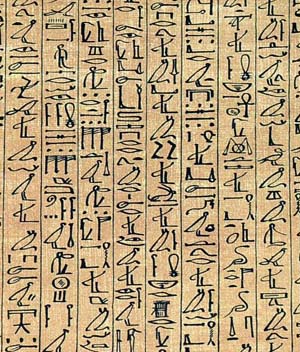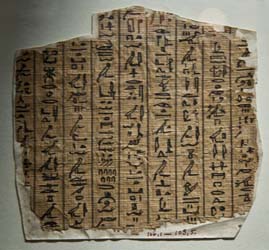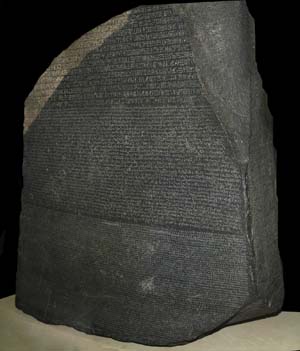Ancient Egyptian Hieroglyphs
The ancient Egyptians had a unique writing system now known as hieroglyphs. These are the little pictures that most people associate with Egyptian writing. However, the ancient Egyptians had two other scripts they used as well.
 Papyrus of Ani, Book of the Dead
Papyrus of Ani, Book of the Dead
One of these is called hieratic, or writing of the priests. This writing also used pictures as symbols, but they were simplified, which allowed the priests to write more easily on papyrus.
Demotic writing was the common use script for regular people. This script did not use pictures.
Both of these types of writing were commonly found on scrolls of papyrus, which was the paper made from a tall plant growing around the Nile River. The Egyptians combined strips of the plant’s stems and pounded them flat with heavy stones. Upon drying, this became paper.
Ancient Egyptian Hieroglyphs
Hieroglyphics were typically carved on walls, tombs, monuments and other places made of stone or brick. They were primarily learned and used by priests and scribes. The latter went through special training to learn hieroglyphics.
The hieroglyphics used pictures to represent both sounds and words. For example, the eye symbol could literally mean “eye” or it could mean the letter “I”. A picture of an arm might mean “arm” or it might mean “strength.”
Hieroglyphs could also be written in any order, from left to right or up to down or the opposite. It was up to the reader to figure out which way it needed to be read based on the direction of the symbols.
 © Quikwhitefox86 – Papyrus Exhibit
© Quikwhitefox86 – Papyrus Exhibit
History of Hieroglyphs
Hieroglyphs started out simply with pictures of the sun, moon and various nature images, but eventually became more complex. Soon pictures did not simply represent themselves, but more nuanced meanings and eventually sounds as well.
Since only priests and scribes used hieroglyphs and they had to be specially trained, the knowledge of how to read hieroglyphs disappeared with Egyptian civilization. At least, until the discovery of the Rosetta Stone.
Rosetta Stone
 © bathyporeia – The Rosetta Stone
© bathyporeia – The Rosetta Stone
Scholars initially thought hieroglyphs were much simpler than they actually were. They assumedthey were simply pictures that meant what they looked like. Then a black stone was uncovered in Egypt that contained three types of writing. On the top was hieroglyphs, in the middle was demotic writing and on the bottom was Greek.
A French scholar named Champollion was able to work out the top two scripts through his understanding of Greek. The black stone, now known as the Rosetta Stone, resides in the British Museum and has been used to translate other hieroglyphics as well.
Meaning of Hieroglyphs
The meaning of hieroglyphs, once understood, was more complex than scholars had thought. The pictures did not simply mean what they appeared, but they also meant other things such as actions. For example, a leg could also mean walking.
- A picture of a house did not just stand for a house, but could also stand for the “pr” sound, which was the ancient Egyptian word for house.
- A picture of a club crushing something could mean to crush salt, or it could mean “heavy.”
- A picture of the shovel used by bakers to put bread in the oven could mean “to bake bread,” or it could stand for any of these three sounds: rth, hnj or hnr.
Ancient Egyptian did not have vowels in their writing so no one really knows how to pronounce hieroglyphs.







































